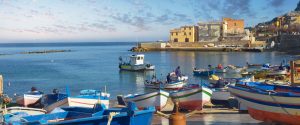Sicilia: The name of this small triangular island evokes such fascination and conjures such clear images – almost to the point where it could be considered independently from Italy, an entity in its own right. How did this come to be? We could borrow the words of the great German writer Goethe and say that it is simply “an unspeakably beautiful land“. But the Mediterranean is filled with spots of natural beauty. What sets Sicily apart?
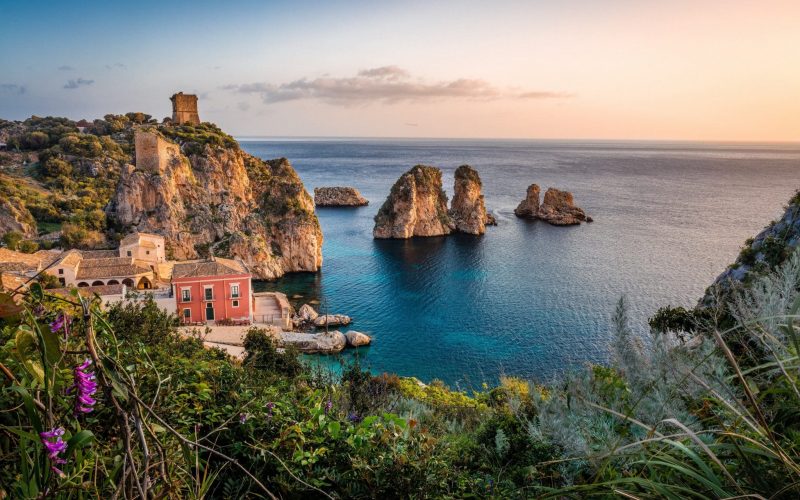
One reason is the richness and complexity of its ancient and modern history. The island was one of the world’s first true cultural melting pots.
Its strategic position and remarkable natural wealth attracted envious eyes from colonists since the dawn of European civilization. Over the past three millennia the Phoenicians, Greeks, Romans, Arabs, Normans, French, Spanish, Austrians and now Italians in turn called this land an important trading and, often, political outpost for their empires. Each of these cultures left their own footprints on the island’s fertile soil, visible today in the form of temples, cathedrals and castles, place names, genetics, gastronomy, mythology and customs.
Always keep this in mind when you come across the contradictions and peculiarities of the Sicilians. All their unique habits, extraordinary generosity and distinct, sometimes hard-to-understand character are borne of this labyrinthine legacy and the presence on the island of traditions and beliefs which often differ profoundly from each other.
To get into the Sicilians’ heads and really understand them, then, you must therefore learn to read the traces of their ancient cultural heritage in their eyes and on their faces. If, after that, you can resist the temptation to relocate to Sicily, we will be amazed!
Climate – Weather in Sicily
The position of the island in the heart of the Mediterranean basin and its particular formation give Sicily an incredible natural and meteorological profile.
The mild Mediterranean climate, for example, gives Sicily about 300 sunny days a year. This allows lovers of the sea the opportunity to swim from April to late October. And there’s plenty of space to do so – Sicily has more bathing coast than any other Italian region (922.9 km).
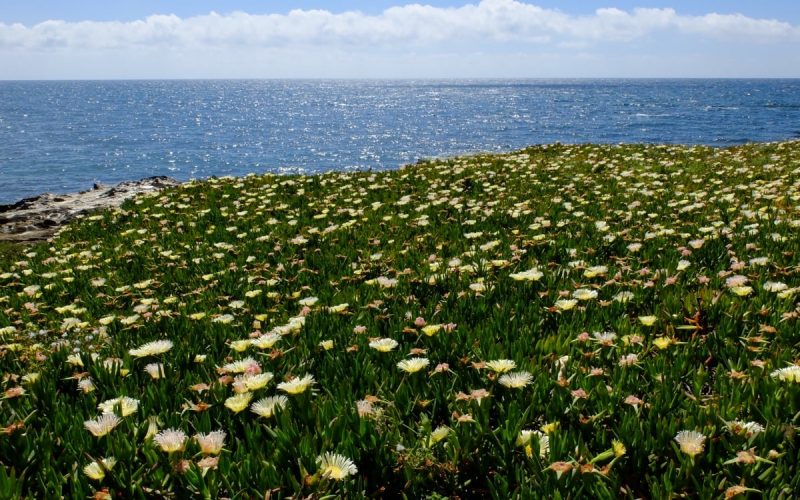
In the graph from Meteoblue you can see just how the weather in Sicily looks like. The temperature in Sicily almost never drops below freezing and our spring begins as early as the end of February.
These numbers are, of course, averages. But as a relatively large and topographically varied region, different areas of Sicily see very different climates.
The north coast, from Trapani in the west along to Messina in the east, is strikingly green, and temperatures are generally milder than the rest of the island. The south coast has a more varied climate. The lower half of the island is flatter, with many fewer mountains and less fresh water. This means that the landscapes around Ragusa, Siracusa and Agrigento are washed with the sandy color palette of the desert.
The climate inland is very different again. There are elevated areas of the island where the winters are very cold and where snow will sit for as long as three months.
Did you ever imagine strapping your skis on in Sicily?
Nature in Sicily
If you love boat trips and long to discover even less explored islands, Sicily has an embarrassment of riches: the famous Aeolian Islands (Messina), the Aegadian and the Stagnone (Trapani), the Pelagias (Agrigento) – which includes Lampedusa; the Cyclopaen (Catania), plus Ustica (Palermo) and Pantelleria which is just 70km off the coast of Tunisia.
If you prefer fresh mountain air, Sicily even offers options for a winter sports vacation. The island has three mountain ranges, the Madonie (where you can find our beloved villages of Pollina, Gratteri and Cefalù), the Nebrodi (the region where many villages started the 1 euro house strategy) and the Peloritani, as well as the highest active volcano in Europe, Mount Etna (which rises 3350m above the city of Catania). On these peaks the climate is essentially alpine, and you will find ski lifts active from December to March.
Finally, lovers of interesting trees will not want to miss the Garibaldi Garden in Piazza Marina, Palermo, where is the largest tree in Europe – a beautiful example of Ficus Macrophylla (Moreton Bay fig) sprawls out to a stunning 10,000m³ of foliage. And in Sant’Alfio, near Etna, you can pay a visit to the gigantic Chestnut of the Hundred Horses, which at 2000 or more years, is believed to be the oldest tree on the continent.
History and Art in Sicily
Sicily is an open-air art history book with pages that deal with every era and style. The prestige of its riches is evidenced by the fact that there are 7 sites on the island considered UNESCO heritage sites, a list which includes 5 sites and artistic endeavors and two sites on the ‘natural history’ list (Etna and Aeolian Islands).
To live your Indiana Jones dreams, strap on the backpack don your fedora and book a guided tour of the rock necropolis of Pantalica, an hour’s drive from Siracusa. As a bonus you can cool off with a refreshing plunge into in the beautiful oases of the nearby Anapo river valley.
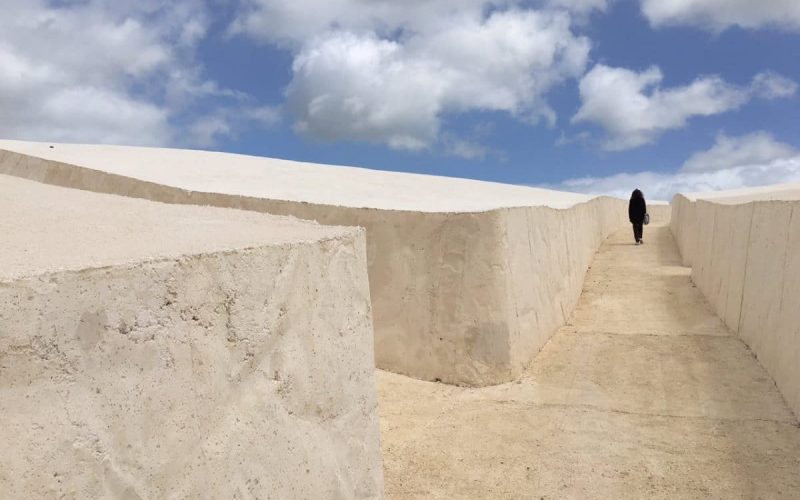
If ancient art is your thing, you may already be aware that Sicily contains some of the best-preserved remains of the Greek era found anywhere in the former Hellenic world: the Valley of the Temples in Agrigento boasts the majestic Temple of Concordia; Siracusa and Taormina each offer splendid Greek amphitheaters used to this day for important theatrical and musical events; and more important Greek sites are waiting to be explored at Segesta, Himera and Selinunte. The island has a remarkable Roman legacy too, in the thrillingly clear mosaics at the Villa Romana del Casale in Piazza Armerina, a specimen of the Roman art that is the equal of any in the world.
Medievalists will be enthralled retracing the footsteps of Sicily’s Norman rulers along the Arab-Norman trail from Palermo to Monreale and Cefalù. If the 17th century is more your taste, you’ll be glad to take the first opportunity to pay a visit to to the magnificent Baroque cities of the Val di Noto.
The island is still a vibrant artistic hub. If you’re a fan of contemporary art we highly recommend paying a visit to the ‘Farm Cultural Park‘ in Favara and the Fiumara d’Arte in Tusa.
Always appreciative of its rich past, Sicily is always developing initiatives to promote its artistic treasures. Of particular note is the ‘Via dei Tesori‘ event held each October. During this celebration of our mutual history, a wealth of aristocratic palaces, art nouveau villas, archaeological sites and beautiful museums can be visited for bargain prices – and are sometimes opened to the public for the only time all year.
If you choose to visit Palermo during this period, our top recommendations are taking the backstage tour of the Teatro Massimo (Europe’s third largest theater), visiting the city’s International Puppet Museum and investigating the prized collection of majolica pottery kept at the Stanze al Genio house museum.
Cuisine and Street Food in Sicily
Mamma mia, where do we start!? Thanks to the wide range of cultures that have settled here over the past millennia, Sicily has a rich and varied cuisine that is the envy of the whole world. Even other Italians admit that if you want to eat well, you need to come and visit us here! You can trace the island’s history through our menus, from the seafood and cheese legacy of Magna Grecia, to the sweet treats brought by the Arabs, and into the Jewish roots of Palermo’s meaty street food.
Sicilian cooking, at its simplest, is rooted in the principles of the famous Mediterranean diet. The basic ingredients are mainly vegetable (wheat, cereals, beans, vegetables, fruit) and seafood (blue fish, tuna, mollusks and much more). Red meat is a little less common, although it does appear in the form of offal. The salt is mainly marine and used in moderation. Flavorings come chiefly from aromatic herbs like basil, parsley, mint, bay leaf, rosemary, sage and wild fennel, or from the island’s plentiful crops of citrus fruits. The base for stuffings and comfort foods usually features some combination of pine nuts, raisins, toasted breadcrumbs, orange zest and lemon juice. Pistachios are also often used in the preparation of both first courses and desserts (the crop grown in the Bronte area is renowned worldwide and widely exported across Europe) and almonds, which are widely present throughout the island.
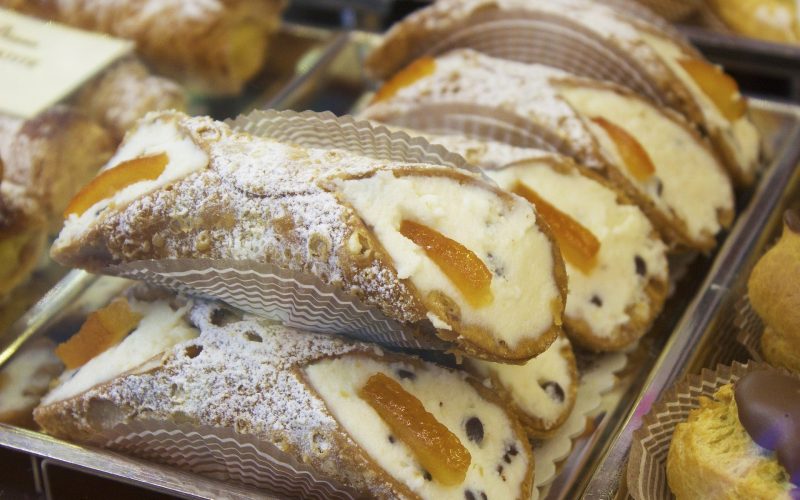
True Sicilian cooks and chefs will use only the highest quality extra virgin olive oil, both for cooking and for seasoning. Butter, is rarely used – the occasional substitute for oil is sugna, an animal fat similar to lard (often used for street food).
An important thing to underline is that a Sicilian dining table will be laden with fresh, organic food and that seasonal and local produce is always preferred.
We must discuss street food, of which Palermo is certainly the undisputed capital. If you want a quick, inexpensive and usually hand-held snack the stalls and kiosks of the city’s streets and markets have you amply covered: you can find sandwiches with panelle (chickpea fritters) or spleen (the famous ‘pane ca meusa’), battered vegetables, stigghiole (entrails wrapped around a leek and grilled), arancine and much more. We’ll be honest, we know they don’t always sound the most enticing but they taste delicious! While you are in Palermo, if you’d like to sample an arancina or croquette in slightly calmer surroundings, we recommend the Antica Focacceria San Francesco. For the full sensory experience, head straight to Vucciria or Ballarò, the two most famous and historic markets of the Sicilian capital – by the way, if you are asking yourself if visiting Palermo might be unsafe, here our extensive article about mafia and crime in Sicily.
Sweet tooth? The deserts and sweets of the island deserve their own separate chapter. Often based on seasonal or dried fruit, and almost always tied to religious traditions, Sicilian sweets are very sugary and very indulgent. Ricotta is often used, for example in cassata and cannoli, and often mixed with chocolate and candied fruit. Another great local product is manna, a sugary resin scraped from the bark of the ash trees, mainly produced in the Madonie and exported all over the world. If you want the perfect setting in which to sample it, pay a visit to the Pasticceria Fiasconaro pastry shop in Castelbuono, a town in the Madonie hills outside Cefalù, and try one of their famous panettone with manna cream. Last but not least, in the town of Modica chocolate is still prepared according to the original Aztec recipe which arrived with the Spanish in the 16th century.
And of course, we can’t fail to mention gelato (ice cream) and granita (crushed ice and fruit drink)! They have always been important elements of daily life in Sicily and (if you’re not careful) can even replace an entire meal! A kind of ice cream (called sherbet) was produced here by the Arabs who mixed the snows of Mount Etna with brown sugar and fruit juices. And homemade ice cream as we know it was the creation of the Sicilian Francesco Procopio dei Coltelli in 1600, who invented a sorbet machine that resembled the modern ice cream makers. Not content with changing the food world once, Procopio then moved to Paris and opened the first Café in the city’s history (the Café Procope). Quite the legacy!

